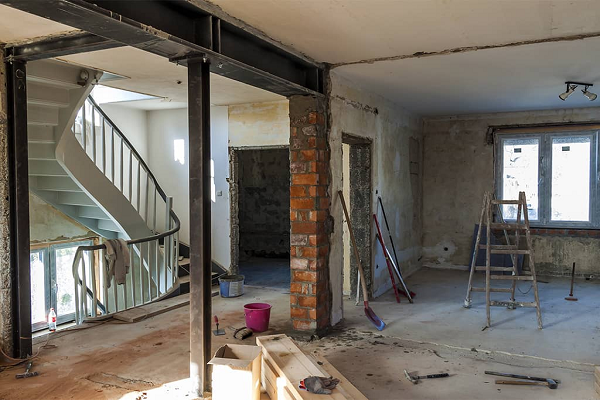Average Rent Prices in London Hit Another All-Time High
Skyrocketing rent prices have been pricing prospective tenants completely out of much of the market for some time. Coupled with the escalating living-cost crisis, millions are finding it difficult (if not practically impossible) to make ends meet.
When and where the whole thing will begin showing at least modest signs of improvement remains to be seen, but things are almost certainly going to get worse before getting any better.
Younger people in the capital are finding themselves particularly hard hit, where the average cost of renting a home has always been disproportionately high. With average weekly rents having once again broken all records, a sizeable proportion of London’s private renting community is considering leaving the city entirely.
According to a new study conducted by the charitable foundation Trust for London, the average cost of renting a home in London is now £533 per week. This represents an increase of more than 16% since the same time last year, at which point private rentals were already completely unaffordable for many.
As a result, as many as one in four young renters are now saying they may be forced to leave London in the near future due to their growing inability to pay their bills and sustain their lifestyles.
Wages are insufficient to cover living costs
The study also indicated that between April and March this year, the average rental price for a one-bedroom property in London was the equivalent of just over 46% of the average Londoner’s gross median pay. By contrast, renters across the rest of the country use around 26.4% of their gross median pay for rent.
Reporting separately, Foxton Estate Agents said that one of the drivers behind skyrocketing rent prices in London was explosive demand, coupled with minimal available inventory. They said that around 23,000 rental properties were listed on the market in September, meaning that an average of 29 people were competing for each property listed.
There are approximately 9% fewer properties available on the private rental market in London than at the same time last year, while demand has increased by as much as 20 per cent.
Consequently, as many as 20% of younger people are planning on leaving London entirely, as they simply cannot afford to keep spending so much of their money on rent costs alone.
Prices are likely to continue rising
As more and more people pile back into big cities following the mass exodus prompted by the coronavirus crisis, average monthly rents in London are predicted to continue increasing.
Speaking on behalf of Hamptons, head of research Beveridge said that the return to the new normal would most likely continue pushing average London rental prices higher.
“With COVID-19 being pushed further to the back of people’s minds, life in the capital is slowly returning to its new normal. Tenants are returning to the bright lights of the city, and this is driving rental growth to record highs,” she said.
“The rise of remote working means that fewer tenants are moving to the capital specifically for work. In fact, a growing number of tenants choosing to live in London are working fully remotely and could live nearly anywhere in the country. The footloose nature of many jobs today means that it will be culture and lifestyle rather than employment that become the capital’s biggest draw.”
“The current pace of London rental growth is predominantly down to the capital playing catch up with the rest of the country.”
“Today, the average rent in London stands 103% above the average outside the capital. While this gap is up from 96% a year ago, it remains below the 120–30% pre-COVID-19 premium, which has been eroded by strong rental growth outside the capital in recent years. But the current pace of rental growth in London is likely to push the premium closer to its pre-COVID-19 level within two years.”
Key Changes to Planning Permission Over the Past 70 Years
Understanding where planning permission rules came from and why they exist holds the key to making sense of them in a modern context. Right now, estimates suggest that at least 300,000 new homes need to be built every year for the next decade, just to ensure the government meets its own lofty housing targets.
In reality, the likelihood of this actually occurring is practically zero.
Critics believe that sweeping changes to planning permission rules and general building regulations could hold the key to turning around the UK’s escalating housing crisis. Whether any such alterations come about remains to be seen, as many developers and construction companies continue to find themselves blighted by overly complex rules and regulations.
A brief history of planning permission
As the Second World War drew to a close, the reconstruction of towns and cities across Britain became the government’s top priority. Plans were also drawn up for developing entirely new towns and cities from scratch.
To get things started, the 1946 New Towns Act established a programme for the development of new towns. This resulted in several areas of the country being designated for new town and city projects, the first of which would emerge as Stevenage.
However, the 1947 Town and Country Planning Act followed soon after, placing heavy restrictions on where rapid urbanisation of rural spaces would be permitted. At this point, planning permission needed to be issued by local councils for any developments to proceed.
In 1955, conservative minister Duncan Sandys requested that local councils prohibit the development of new residential zones on the edges of towns and cities, so as to:
A: Check the further growth of a large built-up area.
B: Prevent neighbouring towns from merging into one another.
Preserve the special character of a town.
From the 1990s
There was a moderate easing of planning permission restrictions in the 1990s, or when the Town and Country Planning Act had been updated. At this point, it would only be necessary to apply for planning permission for projects that formerly met the definition of “development”. Things like changes in the primary use of land or buildings, interior alterations, and projects that do not alter the external appearance of buildings could all be performed without applying for approval.
A General Permitted Development Order was implemented in 1995, providing even greater scope and flexibility for developers. Later in 2013, the government acknowledged that the need for residential spaces across the UK should prompt a rethink of current restrictions.
The rules were modified once again, and the conversion of certain commercial properties into residential homes became exempt from planning permission guidelines. However, some of the country’s less reputable and responsible “cowboy” developers exploited the new freedoms, creating tiny and uncomfortable flats out of office spaces that were never meant to accommodate residents full-term.
Recent changes to planning permission
Most of the recent changes to planning permission rules have focused on raising residential standards. New rules were introduced towards the tail end of the COVID-19 crisis to allow more types of commercial conversions, including the repurposing of medical facilities and gyms into residential units.
As things stand, anyone looking to build something new, make significant changes to an existing building, or alter the main use of a building needs to apply for planning permission. None of which is helping new and aspiring developers get their projects off the ground, but there is at least a dedicated Planning Portal now, which is designed to simplify the process of obtaining planning permission.
Have Property Development and Construction Costs Peaked?
Property developers and construction companies have not had an easy ride as of late. Ever since the COVID-19 crisis hit, the costs of essential building materials have skyrocketed to unprecedented highs. The war in Ukraine took a further toll on already stretched supply lines, making it impossible for developers to turn a profit without imposing their own lofty price hikes.
With the UK facing its worst collective living-cost crisis in recent history, the immediate outlook for the average household is fairly bleak. But there may be at least a small degree of respite on the horizon for builders and property developers, as construction costs are beginning to plateau.
Better yet, there is reason to believe that building costs will begin to decrease going into 2023, enabling developers and construction companies across the UK to kickstart (or restart) their planned projects.
Will the economic downturn trigger a reduction in building costs?
One of the reasons why building costs increased significantly towards the tail-end of the COVID-19 crisis was the simply insurmountable divide between demand for building materials and available supply. Developers and construction companies across the UK raced to keep up with demand, and in doing so completely swallowed up the available contingency of key materials.
Supply lines dried up, availability of essential materials hit rock bottom and prices skyrocketed as a result.
When this happens, many developers and construction companies decide to shelve planned projects or put their existing projects on hold. They simply had no realistic way of generating meaningful profits with such elevated building costs, so they made the decision to wait things out. Their aim was to sit tight until the market returned to some kind of normality, rather than paying over the odds, and reducing the profitability of their projects in the meantime.
All of this seems to be paying off for many, who have already noted a significant reduction in the cost of some essential building materials. Some have even reported that compared to the end of Q2, they are now receiving quotations up to 10% lower on key materials and components.
These reductions in building costs are resulting from two things: A period of comparatively low demand when costs were disproportionately high and the rectification of a broad range of supply chain issues. Key building materials are still not available in the same plentiful supply they once were but are no longer as difficult to come by.
As a result, the manufacturers and suppliers are not able to charge such high prices for them and low prices are gradually trickling through to property developers and construction companies.
In forwards into 2023
Of course, putting too much stock into what is happening (or appears to be happening) right now may not be advisable. The events of the past few years have taught us that nothing is set in stone, and we have no idea what may be around the next corner.
As the crisis continues to escalate in Ukraine, it is perfectly plausible that major supply chain issues could once again cripple the UK’s property development sector.
Even so, the consensus seems to paint a picture of a slightly more stable and predictable future for the industry as a whole. Building material, component and labour costs may remain elevated indefinitely but are unlikely to hit the same kinds of peaks as those experienced at the height of the COVID-19 crisis.
Property developers and construction companies are exercising greater care and caution than ever before, and in today’s turbulent climate are unwilling to take the kinds of risks they would once have happily accepted as the norm.
How Much Do Property Renovations Cost (and Can You Avoid Overpaying)?
The past 12 months alone have added an average of £39,000 to the market value of a UK home. Millions of homeowners have found themselves sitting on a small fortune and understandably want to get the best possible return on their investments.
Conducting home improvements and renovations is one of the best ways to maximise a property’s value before listing it for sale. But exactly how much does it cost to renovate a home, and how can you ensure the improvements you make generate respectable profits?
How much do renovations cost?
A combination of factors over the past few years has seen the costs of property renovations skyrocket. From basic building materials to labour to the latest green technologies, prices across the board are on the rise.
The average loft conversion, for example, now costs around 25% more to undertake than it did two years ago. Alarmingly, the cost of installing a new bathroom in a residential property is also up by as much as 40%.
Renovation costs vary significantly from one property type and area of the UK to the next. According to the Homeowners Alliance, this is how much you can expect to pay to renovate and improve your home in 2022:
| PROJECT | HOUSE RENOVATION COST |
| Extension | £26,000 – £34,000 |
| Loft conversion | £45,000 |
| New bathroom | £6,000 |
| New Kitchen | £10,000+ |
| Garage conversion | £6,000 |
| Subsidence | £6,000 |
| Damp | Up to £16,000 |
| Double glazing | £400 — £600 per window |
| Installing central heating | £4,000 |
| New boiler | £2,700 |
| New roof | £4,500 – £12,000 |
| Fixing rot | £1,000 – £2,000 |
| Woodworm treatment | £450 – £800 |
Source: hoa.org.uk
On top of the above, experts advise allowing an additional 10% to compensate for unexpected issues and additional costs encountered along the way.
What are the best renovations to add value to a property?
When it comes to generating the best possible ROI with property renovations, some home improvements are known to generate bigger profits than others.
For example, a loft conversion has the potential to generate the biggest profit of all (an average 16% property price increase), followed by a double-story extension at 15%. A single-story extension will typically increase a home’s value by 11%, whereas a complete kitchen renovation can contribute 10% to a property’s resale value.
Meanwhile, adding a conservatory to your home could increase its market value by 9%; a single garage can add an average of 7% to the value of a home; and a medium-scale bathroom refit can contribute 4%. Surprisingly, simply painting and decorating the interiors of a property can boost its asking price by as much as 3%.
How to avoid overpaying
Irrespective of the type of renovations you set your sights on, it is up to you to ensure that you don’t overpay. Before entering into a contract with any builders or construction companies, ensure that they are registered with the likes of Trustmark, the National Federation of Builders, or the Federation of Master Builders.
Using Checkatrade to verify the credentials of other types of contractors is highly recommended, as is requesting recommendations and references from past customers.
Fixed quotations should always be issued in advance of the commencement of a project, and all essential terms and conditions must be agreed upon in writing. You should also be given as much time as needed to evaluate the provider’s reputation and stature, with no pressure to go ahead at any time.
Online reviews and recommendations alone can give you a good idea of whether a service provider or contractor is worth doing business with. If there is a disproportionate quantity of negative feedback or anything untoward about their track record, you could be taking a risk by putting your home in their hands.
How Green Technology Can Reduce Energy Bills
Up and down the country, landlords and everyday households are scurrying to find any and every viable solution to the UK’s spiralling energy bills. This year may have brought Britain’s hottest temperatures on record, but the prospect of an exceptionally bleak winter is already taking its toll on the nation’s welfare.
The escalating living-cost crisis was and is one of the most pressing issues for Liz Truss, who just days into her premiership announced plans to freeze energy bills at an average of £2,500 a year for two years. The announcement came as part of much broader support packages for households and businesses, but whether she remains in power long enough to come through on any of her pledges now remains to be seen.
Indeed, there are those in government (including several prominent members of the Conservative Party) who believe Liz Truss will be ousted before the end of the month.
Either way, capping energy bills at an average of £2,500 a year for two years is not something most would praise as a major step in the right direction. It still represents a major increase from last year’s average household energy bill of £575 for gas and £764 for electricity.
Striving for longer-term savings
A joint study conducted by Scottish Power and the World Wildlife Fund (WWF) found that the average household could save almost £1,900 per year by upgrading to the latest green technologies. This includes advanced insulation, the installation of heat pumps, and the use of solar panels.
All of these devices work in different ways, but they are ultimately designed to reduce energy consumption and bring household energy costs under control.
Unfortunately, stepping up to these kinds of green technologies is not something that comes cheap. It can cost anything from £7,000 to £13,000 to install a heat pump, while solar panels for the average home will typically carry a price of between £5,000 and £11,000. With the living cost crisis biting harder than ever before, this simply is not the kind of money most people have at their disposal.
This is where government bursaries and grants can offer at least a modest lifeline to many households and landlords. The Green Homes Grant scheme has now come to an end (at least in the sense that no further applications are being accepted), but there are still initiatives like the Boiler Upgrade System that can pave the way for significant discounts.
One grant application can be submitted per property, which (if successful) could be worth as much as £5,000 to £6,000 off the price of installing a heat pump or biomass boiler, either of which could significantly boost a property’s energy efficiency and effectively pay for itself long-term.
Improved property values
Along with reduced household energy bills, property owners are being prompted to consider the extent to which green improvements can increase a home’s market value. Specific figures are hard to come by, but the study conducted by Scottish Power and the World Wildlife Fund (WWF) suggested that the average home could see a £10,000 boost to its market value through the adoption of green technologies.
But as all green technology grants and incentives introduced by the government to date have been strictly temporary in nature, those looking to take advantage of any such discounts are advised to do so as promptly as possible. Landlords in particular stand to make significant savings by investing in green technologies for their rental properties, as the countdown continues to the introduction of the government’s tightened carbon emissions rules for all UK households.
How Breathing Space Regulations Can Adversely Affect Lenders
Throughout the COVID-19 crisis, tenants and mortgage payers were afforded additional protection from the potential consequences of temporary financial turbulence. Where individuals, families, or businesses were unable to meet their repayment obligations through no fault of their own, they were governed by emergency government legislation. At least, to such an extent as to give the person time to get their affairs in order and to get back on top of their financial commitments.
Recently, figures published by the Ministry of Justice suggest that things are returning to normal. In terms of the basic numbers, warrants and repossession orders are once again back to levels similar to those recorded prior to the pandemic. A significant rise in the number of repossessions commenced or carried out in March was recorded (compared to the same quarter last year), and the ASTL has reported a 31.5% increase in the value of loans in default.
Contrary to popular belief, lenders always approach repossession as a last resort option. Repossession is a costly, complex, and time-consuming process, which ultimately leaves all parties involved out of pocket. Even so, it is a necessary mechanism to enable lenders to safeguard themselves from heavy losses.
The debt respite scheme
Following the withdrawal of COVID-related protections from repossession and eviction, the government introduced the Debt Respite Scheme, also referred to as Breathing Space; the policy came into force on May 4, 2021.
According to the government, the new regulations were introduced to give individuals the time they need to enter sustainable debt solutions and to encourage people to seek advice on their debts and outgoings.
In short, the policy provides those who qualify under its terms and conditions a period of 60 days of ‘breathing space’. During this time, their creditors (and the collection agents representing them) cannot issue any demands or progress with enforcement. However, all interest, fees, and penalties that apply during this 60-day suspension period still apply.
But what seems to have been overlooked by those who drafted the legislation is how a 60-day ‘breathing space’ period can be somewhat disproportionate, from one loan type to the next. The same 60 days apply (if the borrower qualifies), irrespective of whether they are repaying a 30-year mortgage or a six-month short-term loan. In the case of the latter, 60 days would be a full 30% of the entire repayment period—the equivalent of a ten-year hiatus on a 30-year mortgage.
Either way, the latest figures published by the Insolvency Service suggest that the vast majority of those registering under the Breathing Space are perhaps not using the facility in the way it was intended to be used. Of the 49,017 cases accepted during the programme’s first year, 96% of those taking advantage of the scheme ran out of time within the 60-day allotted period. Just 668 entered into a viable debt management solution, while only 222 came up with ways to repay their debts within 60 days.
All of this has prompted calls for the terms and conditions of the policy to be revisited to protect lenders from potential losses. Breathing Space is used most broadly as a way to forestall repossession or eviction, as opposed to its intended purpose of a sustainable debt solution. Lenders have the option of launching counter-challenges against breathing space cases, but the process is long-winded, complicated, and costly.
There is no argument or contention among lenders that well-intentioned debtors should be given the support they need to weather turbulent financial times. The issue is that with policies like Breathing Space, the programme is wide open to abuse and exploitation.
Title Fraud a Growing Threat to More Than 97% of UK Homes
Rapidly rising levels of “title fraud” are prompting homeowners in record numbers to register for property alerts with the Land Registry. Alarmingly, research suggests that as many as 97% of homeowners face the threat of their properties being sold illegally, without their consent or their knowledge.
Between 2020 and 2021, the Land Registry recorded a 300% increase in the number of people registering for property alerts. New data published by Third fort based on a Freedom of Information request suggests that title fraud is being taken seriously by more homeowners than ever before.
Even so, the numbers indicate that just 515,000 property owners have so far registered for the service, which is free of charge for all homeowners in England and Wales. This equates to just 2.5% of all property owners across the two countries.
Around 135,000 people registered their homes in 2021, up from 46,000 in 2020. Meanwhile, 110,000 have signed up so far this year. This leaves 97.5% of properties unregistered for the service or 20.3 million homes.
Speaking on behalf of Third Fort, Olly Thornton-Berry highlighted the extent of the problem.
“Fraud is a huge problem in the UK property market,” he said.
“We’ve seen some alarming instances of fraudsters acquiring ownership of properties using forged documents to impersonate registered owners. Empty properties, tenanted properties and those without a mortgage are particularly at risk.”
The importance of property alerts
Late last year, a homeowner from Luton returned to his property after spending a period of time in Wales on business. Only to find that when he arrived home, somebody had moved into his house, replaced the locks and started to renovate his property.
An investigation conducted by the BBC found that he had fallen victim to identity theft and that his house had been sold fraudulently in his absence.
This represents just one of many instances of title fraud (and attempted title fraud) that take place across England and Wales each year. By signing up for free alerts, it becomes possible to thwart the attempts of fraudsters by receiving a notification the moment suspicious activity is detected.
As explained on Gov.co.uk:
“We will send you an email alert each time there is significant activity on the property you are monitoring, such as if a new mortgage is taken out against it.”
“The alert will tell you the type of activity (such as an application to change the register or a notification that an application may be due), who the applicant is and the date and time it has been received.”
“Not all alert emails will mean fraudulent activity. If you don’t think the alert email is about any suspicious activity, you don’t need to do anything.”
“Signing up to Property Alert won’t automatically stop fraud from happening. You will need to decide if the activity on the property is potentially fraudulent and act quickly if so. The alert email will tell you who to contact.”
Who is eligible for automatic alerts?
The official government page for Land Registry property alerts outlines the following eligibility requirements for the free service:
- The property you want to monitor must be situated in England or Wales and registered with HM Land Registry
- You must create a Property Alert account to use the service
- You will receive an HM Land Registry email (please check your spam inbox) to enable you to verify your email details
- You must then sign in to your account to add a property
- Email alerts are sent when official searches and applications are received against a monitored property
- If you receive an alert about activity that seems suspicious you should take swift action. The alert email will signpost you to whom to contact.
- You don’t have to own a property to set up an alert
- The same property can be monitored by different people.
- Property, especially flats, can be registered with two titles. Blocks of flats are often owned by companies (Freehold), and the person owning the individual flat (Leasehold). When registering for this service please choose Leasehold title for individual flats.
- You can use the service if you are not online. Call the Property Alert team on 0300 006 0478.
Source: Gov.co.uk
Private Renters Now One Bedroom Worse Off Than Two Years Ago
The spending power of private rental tenants in the UK has shrunk to such an extent that the average renter is now one bedroom worse off. Skyrocketing costs combined with a disastrous shortage of available inventory are forcing renters across the country to scale down their ambitions and expectations when seeking affordable rental properties.
Analysis conducted by Hamptons Estate Agents suggests that two years ago, tenants able to spend £929 on monthly rental payments could comfortably afford a two-bedroom property in a desirable location; today, this same budget would only stretch to a one-bedroom home in the same location.
This means that in the course of just two years, private renters have effectively seen a full bedroom wiped off their spending power.
Hamptons report that the average monthly rental cost of a two-bedroom home is approximately £1,070. 16 months ago, this would have been more than enough to rent a three-bedroom property of the same standard in a similar area.
This indicates the fastest and most severe renting power erosion Hamptons has recorded, and the situation is only set to worsen over the coming months.
Skyrocketing monthly rents
Over the past two years, the average cost of renting a property privately in the UK has increased by more than 16%. For the typical private tenant, this equates to another £165 per month on their rental bill.
The last year alone has brought an average rental cost increase of 8.3%, spurred by record demand for affordable rental properties in desirable areas.
Chronic shortages in the private lettings market are worsening as landlords across the UK liquidate their portfolios to escape rising interest rates and unfavourable government legislation. Figures from Hamptons suggest that the total number of available rental properties for July was 9% down on the same month last year and a huge 52% down from July 2020.
Commenting on the figures, Aneisha Beveridge of Hamptons suggested that the worst of the financial squeeze is yet to come.
“Tenants aren’t seeing their budgets stretch as far as they used to, and they are likely to be squeezed further still by a mix of investors leaving the market and the landlords left behind looking to pass on their higher mortgage costs,” she said.
A mass market exodus
Private landlords, particularly those with more compact property portfolios, are exiting the UK lettings sector at a growing pace. As it becomes increasingly difficult to turn a profit with a buy-to-let portfolio, landlords are finding themselves with little choice but to sell some or all of their homes to private buyers or investors.
All of this is placing further pressure on the private rental sector as available inventory becomes increasingly scarce. There are far fewer landlords purchasing properties than selling up and exiting the sector; more than 50,000 rental properties are expected to be lost from the market this year alone.
Ms Beveridge highlighted how the situation is not only affecting those looking to rent for the first time but also for tenants planning to relocate to other parts of the country.
“Those trying to move are increasingly faced with market rents rising faster than what they’ve been paying for their current homes,” she added.
“Often this means they face compromising on what and where they rent next, with some having to trade down.”
Significant cost increases are to be expected by anyone looking for a new tenancy or planning to renew their tenancy over the coming months. The figures in London make for particularly painful reading, where average rents have soared by as much as 33% over the past year.
On average, it now costs £2,672 per month to rent a home in inner London.








